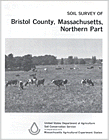Soil Survey of Bristol County, Massachusetts
NORTHERN PART

The following Map Unit Description is from the 1981 Soil Survey of Bristol County, NORTHERN Part. Please note: map unit symbols are DIFFERENT for Bristol North and Bristol South reports, do NOT use these descriptions for Bristol South.
MB-Medisaprists, sandy surface. These soils are nearly level and very poorly drained. They consist of deposits of organic material that have been modified for the production of cranberries by the addition of thin layers of sand to the surface of the organic material. The mapped areas range from 5 to 80 acres in size.
The soil consists of about 6 inches of coarse sand over- lying 16 inches to 10 feet or more of black to very dark grayish brown or reddish brown, partly decomposed organic material. The layers vary in color, thickness, and composition.
Included with these soils in mapping are areas of soils in which the thin sand layer overlies mineral material or organic material that is less than 16 inches thick. Included soils make up about 25 percent of the map unit.
Permeability is moderately slow to rapid, and available water capacity is high. The water table is controlled. Reaction ranges from extremely acid to slightly acid.
These soils have poor potential for farming, urban use, sanitary waste disposal facilities, and trees. They have good potential for wetland wildlife habitat.
The soils are well suited to cranberries. They are unsuited to cultivated crops, hay, and pasture because of the high water table and low bearing strength.
The soils are unsuited to most trees because of the high water table. They are suited to red maple.
The soils are limited for urban use and for sanitary waste disposal facilities. Limitations are the high water table and hazard of flooding. Capability subclass VIIw. Click Here for More Info on this Map Unit
MC-Medisaprists, deep. These soils are nearly level and very poorly drained. They consist of deposits of or- ganic material in depressions. The mapped areas range from 5 to 500 acres in size.
The soil extends to a depth of 60 inches. It consists of layers of black to very dark grayish brown or reddish brown, partly decomposed organic matter that varies in color, thickness, and composition. The depth to mineral material ranges from 30 inches to more than 10 feet.
Included with these soils in mapping are areas of Whitman, Scarboro, and Birdsall soils and Medisaprists, shallow, that are generally less than 4 acres in size. Included soils make up about 20 percent of the map unit.
Permeability is moderate to rapid, and available water capacity is high. The root zone is restricted by a high water table that is at or near the surface more than 9 months of the year. Soil reaction ranges from extremely acid to strongly acid.
These soils have poor potential for farming, urban use, sanitary waste disposal facilities, and commercial trees. They have good potential for wetland wildlife habitat. Most acreage is in poor quality woodland; however, some acreage is in stands of Atlantic white cedar .
The soils are not suited to cultivated crops, hay, and pasture. They have a high water table.
The soils are not suited to commercial hardwood trees because of the high water table. They are suited to Atlantic white cedar.
The soils are limited for urban use and sanitary waste disposal facilities. Limitations are the high water table, hazard of flooding, and low bearing strength. Capability subclass VIIw. NOTE: Medisaprists, deep are now mapped Freetown Soils click for more info.
MD-Medisaprists, shallow. These soils are nearly level and very poorly drained. They consist of deposits of organic material in depressions. The mapped areas range from 5 to 100 acres in size.
The soil extends to a depth of 30 inches. It consists of layers of black to very dark grayish brown or reddish brown partly decomposed organic material that varies in color, thickness, and composition. Depth to mineral material ranges from 16 to 30 inches.
Included with these soils in mapping are areas of Whitman, Scarboro, and Birdsall soils and Medisaprists, deep, that are generally less than 4 acres in size. Included soils make up about 20 percent of the map unit.
Permeability is moderate to rapid, and available water capacity is high. The root zone is restricted by a high water table which is at or near the surface more than 9 months of the year. Reaction ranges from extremely acid to strongly acid.
These soils have poor potential for farming, urban use, sanitary waste disposal facilities, and commercial trees. They have good potential for wetland wildlife habitat. Most acreage is in poor quality woodland.
The soils are not suited to cultivated crops, hay, and pasture. They have a high water table.
The soils are not suited to commercial trees because of the high water table. Some areas of soil support stands of Atlantic white cedar.
The soils are limited for urban use and for sanitary waste disposal facilities. Limitations are the high water table, hazard of flooding, and low bearing strength. Capa- bility subclass VIIw. NOTE: Medisaprists, shallow are now mapped Swansea Soils click for more info.